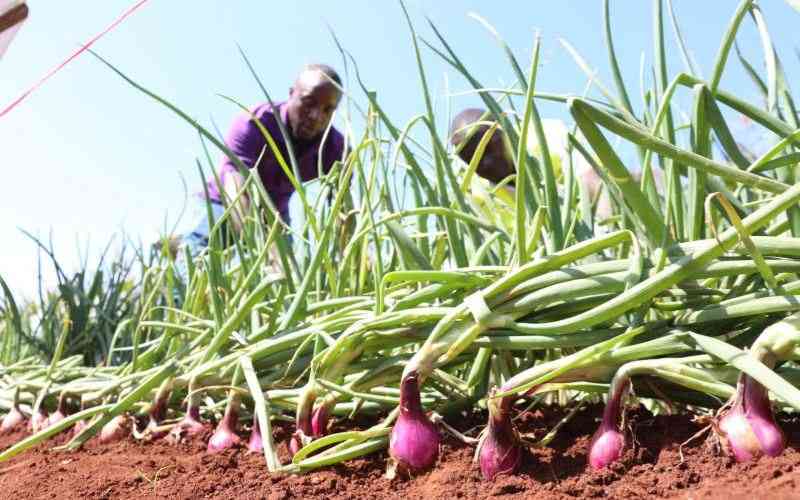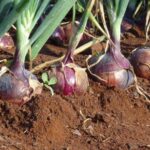Spring onions are among the most popular and profitable onion varieties in Kenya, thanks to their quick growth cycle, low maintenance needs, and strong market demand. This article explores the best practices for spring onion farming, from choosing varieties and preparing the land to harvest and marketing tips for Kenyan farmers.
Popular Spring Onion Varieties in Kenya
Several varieties of spring onions are commonly cultivated in Kenya, each with unique attributes suitable for different climates and tastes:
- White Lisbon: Known for its mild flavor and early maturity, making it a popular choice for local consumption.
- Spring Green Bunching: A variety prized for its long green leaves and high yields, ideal for commercial farming.
- American Flag: This variety is known for its mild taste and thick stems, making it suitable for culinary use in homes and restaurants.
- Italian Giant: A larger variety with a stronger flavor, ideal for high-yield farming.
Ideal Growing Conditions for Spring Onions
For optimal yield and quality, spring onions should be planted in environments with the following conditions:
- Soil: Light, well-drained soils with a pH range of 6.0-7.0. Spring onions do well in fertile soil rich in organic matter.
- Temperature: Moderate temperatures between 15°C and 30°C.
- Rainfall: Spring onions thrive in well-distributed rainfall of around 500-700 mm annually.
- Altitude: Ideal growing altitudes range from 500 to 2,000 meters above sea level.
Steps for Planting Spring Onions
Nursery Preparation and Seed Planting
Farmers can start with direct seeding or grow spring onions in a nursery and later transplant them to the field.
- Prepare Raised Beds: Create raised beds about 1 meter wide with furrows 5 cm apart and 2 cm deep.
- Add Fertilizers: Mix well-decomposed organic manure or phosphate fertilizers to enhance soil fertility.
- Seed Spacing: Sow seeds in furrows, spacing them about 15 cm apart, and cover with a thin layer of mulch to retain moisture.
- Germination: Germination occurs approximately 10 days after planting. Once seeds sprout, remove the mulch and provide partial shade to young seedlings.
Transplanting
Once seedlings reach about 10-15 cm in height, they are ready for transplanting. The process should ideally be done early in the morning or late in the evening to avoid heat stress.
- Watering: Ensure proper watering before and after transplanting to maintain soil moisture.
- Spacing: Transplant seedlings at intervals of about 10-15 cm apart, giving each plant enough space for bulb development.
- Topdressing: After 4 weeks, apply topdressing using Calcium Ammonium Nitrate (CAN) at about 9 kg per acre to boost growth and yield.
Pests and Diseases
Spring onions are relatively resilient but can be affected by common pests and diseases that target the allium family.
- Pests: Leaf miners, onion flies, and thrips can damage spring onion leaves and stunt growth.
- Diseases: Downy mildew, purple blotch, onion rust, and fusarium wilt are common diseases that affect spring onions.
Management Practices:
- Use recommended pesticides and insecticides to control pests.
- Practice crop rotation to minimize the recurrence of pests and diseases.
- Maintain field hygiene by removing infected plants and ensuring the fields are clear of weeds.
Harvesting
Spring onions take about 2 months to mature and can be harvested when the leaves are green, fresh, and succulent. Harvesting can be done in two ways:
- Full Uprooting: Pull the entire plant from the ground for sale as fresh produce.
- Selective Harvesting: Trim the leaves, allowing the plants to regrow for multiple harvests from a single planting.
With optimal spacing and proper care, an acre can yield around 8 tonnes of spring onions, though yields vary based on factors like soil quality and climate.
Market Opportunities for Spring Onions in Kenya
Spring onions enjoy robust demand across local and urban markets in Kenya. Farmers can sell directly in:
- Open-Air Markets: Popular marketplaces where vendors buy in bulk for resale.
- Local Groceries and Mama Mboga Stalls: Spring onions are a staple ingredient, often sold alongside other fresh produce.
- Institutions: Schools, hotels, restaurants, and hospitals purchase spring onions for daily meal preparation.
With the steady demand for fresh produce in Kenya, spring onion farming is a profitable venture for small and large-scale farmers. By adopting proper farming techniques and aligning with market demands, farmers can maximize their returns on this fast-maturing, versatile crop.





